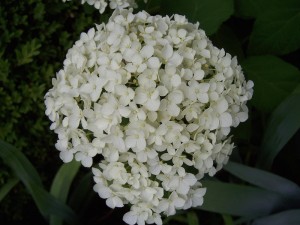Wild Hydrangea – July 2016 Wildflower of the Month
 Hydrangeas are a popular garden plant, especially the old-fashioned snowball, or ‘Annabelle’ hydrangea which is a naturally occurring variant of the Wild or Smooth Hydrangea. This species is native to nearly every county in Virginia, growing in ravines, wooded slopes and stream banks from New York to Florida and west to Iowa, Missouri, Oklahoma and Louisiana.
Hydrangeas are a popular garden plant, especially the old-fashioned snowball, or ‘Annabelle’ hydrangea which is a naturally occurring variant of the Wild or Smooth Hydrangea. This species is native to nearly every county in Virginia, growing in ravines, wooded slopes and stream banks from New York to Florida and west to Iowa, Missouri, Oklahoma and Louisiana.
Wild Hydrangea is a widely branched shrub with gray-brown stems covered with dark green, rounded leaves with small, sharp teeth along the edges. Easily grown in well-drained, moist soils, the plant is low maintenance, and will tolerate clay or rocky soils. Groups of this shrub make a nice addition to a woodland garden in part shade, or as a perennial border background. The leaves turn yellow in the fall and while the whole plant may die to the ground in a harsh winter, it comes back in the spring.
Flower heads appear in May as flattened spheres, first greenish, then creamy white, 6-inches across. Blooming continues through July, with scattered flowering until fall. Since the plants make flowers on new wood, the stems can be pruned back close to the ground in late winter to encourage vital new growth. The flowers on ‘Annabelle’ hydrangea are larger, 8-12 inches across, on strong, straight stems.
These plants are often confused with the Chinese snowball viburnum (Viburnum macrocephalum), another deciduous shrub with ball-shaped white flower heads, 5-8 inches wide. Both shrubs have dark green, toothed leaves, opposite on the stem. The viburnum is a larger shrub, growing to 20 feet in height, in full sun; the blooming period is shorter, and it is not as cold tolerant.
Many cultivars of hydrangea species are available in nurseries and garden centers, and are popular with gardeners. The mopheads and lacecaps (Hydrangea macrophylla), native to Japan, come in pink or blue varieties, depending on the composition of soils. Another eastern Asian species “PeeGee” hydrangea (H. paniculata) often forms flower heads somewhat pyramidal in shape. They require full sun and can be pruned to form a full tree.
Oakleaf Hydrangea (H. quercifolia) is native to southeastern U.S., growing best in Georgia and Louisiana. This deciduous shrub is smaller, less than 8 feet tall and forms large panicles of white flowers in summer. The dark green leaves have 3-7 lobes, resembling those of oak trees.
But many cultivars and non-native hydrangeas have no flowers for wildlife. The native Wild Hydrangea provides food for a variety of bees, beetles, ants and flies that also provide pollinating services for gardens.
By Helen Hamilton, past-president of the John Clayton Chapter, VNPS
Photo: Wild Hydrangea ‘Annabelle’ (Hydrangea arborescens taken by Phillip Merritt)
